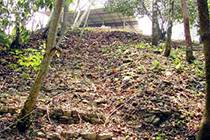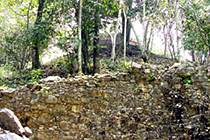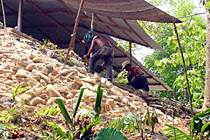
![]()
| In many years of field experience, I've never encountered a puzzle quite like Temple XX of Palenque (map). Its liberation was begun in the year 2001 by the Palenque Group of the Cross Project (PGC) under the auspices of Mexico's National Institute of Anthropology and History (INAH), San Francisco's Precolumbian Art Research Institute (PARI), and the University of Texas's Center for the History of Ancient American Art and Culture (CHAAAC). The work continues to this day, with the objectives of scientific investigation, conservation of the monument and its preparation for tourism. |
| We are now in the final phase of stabilization and consolidation and in preparation for exhibition to the public. This process of consolidation and meticulous restoration by our project has posed a series of questions that appear to be impossible to resolve. Excavation has revealed a number of factors which are hard to reconcile with any consistent vision of this enormous structure as it must have been in ancient times. |  East side, where the terrace levels will be indicated in the final restoration. |
 South side, where the terrace surfaces and unconsolidated area at the base are being covered with grass. | One can see, for example, that the destruction of the eastern and southern facades was extensive, yet the amount of rubble encountered does not match the volume of construction material. In the west, on the other hand, the stepped walls are still preserved in large part, but their masonry, dimensions and arrangement do not correspond to what evidently existed on the other two sides. |
| The situation was slightly clarified by the archaeologists and restorers, but it remains a potential source of confusion for the visiting public unfamiliar with the background. The puzzle was hard to solve, but the archaeologists now understand it as a very clear example of renovation undertaken in Late Classic times at the very moment of the so-called Collapse, for which reason the remodeling was never completed. |  West side, where the stones of the upper three terraces are being mortared into place above the well-preserved lower terraces. |
 North side, where the stones of the pyramid above the wall of Temple XX-A will be mortared into place. | The explanation is simple, and we can summarize by saying that this great structure reflects several chapters in the history of Palenque, in every one of which it was remodeled or at least partially modified. Its oldest version dates to AD 540. Then the burial of a person not yet identified partially destroyed the upper structure in order to introduce the tomb which we know today only by a small aperture but which will soon be investigated formally. |
| It is evident that this structure was modified at least three times before K'inich Ahkal Mo' Nahb' III decided to totally remodel it. This took place after the year 720. Undoubtedly the old structure, built for one of his ancestors, no longer conformed to his objectives and suffered from some deterioration and structural instability. This special ruler, who emerged after political conflicts as the savior of Palenque, decided to begin the work of renovation on the west side, perhaps because it was the least damaged part of the monument. |  The upper terraces on the east side are being consolidated. |
 Northwest corner: the collapsed staircase on the right is being consolidated. | The preparations for remodeling included the intentional destruction of those parts of the terrace facades that did not comport with the new design, which explains the absence of rubble in a ruin of such great size. Moreover, it is clear that the new construction was never finished and its dimensions and materials are very different. |
|
The confusion for a visiting observer is very natural, in that what we see on the west is the incomplete remodeling, while on the south we see only a small portion of the oldest version. Between the two sides, apart from the change in materials, is a distance of approximately 160 years. The footprints of time and especially of history cannot be covered over. We lack the right to restore that which the Maya themselves destroyed, much less make a falsehood of this testimony of the past. In order to avoid it, we must publish a little guide that takes into account something of these fascinating histories of the splendor and decadence of Palenque.
Temple XX will soon be open to the public. But even though its restoration and stabilization will come to an end, that leaves the central part of the Project's objectives. That is, to define and identify its first occupant, who now lies in its funeral crypt surrounded by significant objects and painted murals.
|